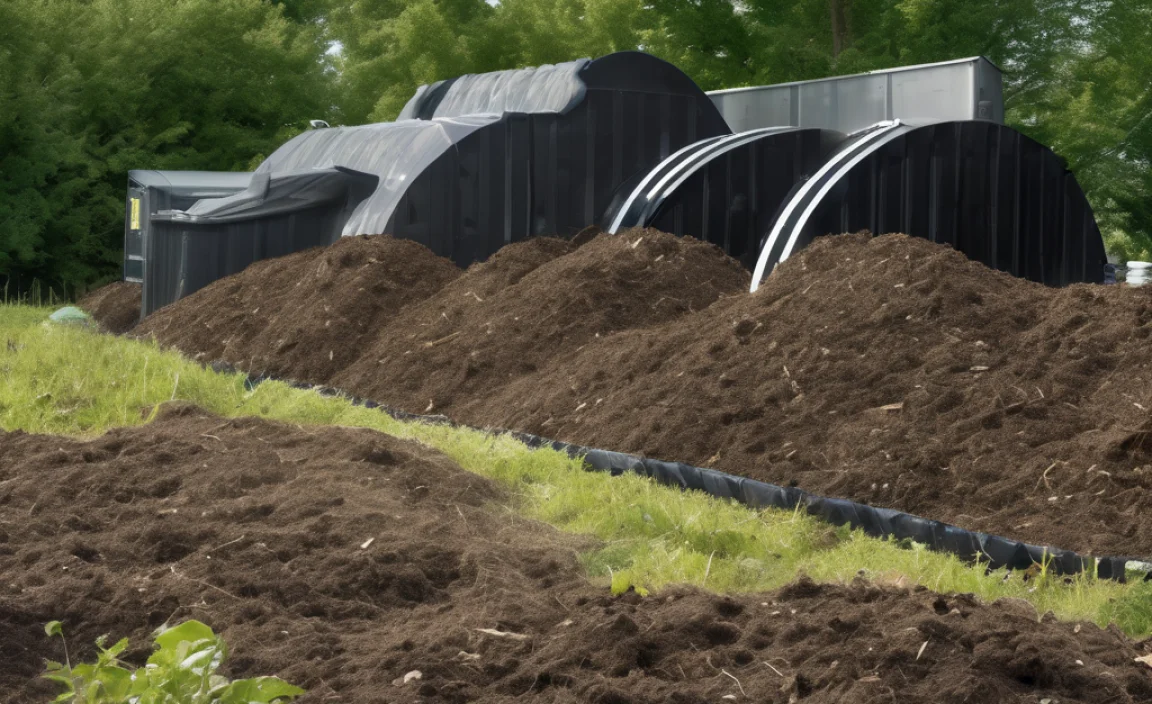Hey there, DIY friends! Troy D Harn here from TopChooser. Ever tried to use a loud air compressor and felt like you were disturbing the whole neighborhood? Yeah, I know the feeling. It can be a real bummer, especially when you just want to get a small project done. But don’t you worry! Finding a quiet air compressor that’s also just the right size for home projects is totally doable. We’re going to dive into the world of ultra-quiet 3-gallon air compressors and find the perfect one for you. Stick around, and we’ll make sure you’re not only heard but also understood by your neighbors!
The Best Ultra Quiet 3 Gallon Air Compressor: Your Essential Guide
Let’s face it, when you think of air compressors, the first thought might be a buzzing, roaring monster that rattles the windows. But what if I told you there’s a whole category of compressors designed to be gentle on your ears? We’re talking about ultra-quiet 3-gallon air compressors. These little powerhouses are perfect for a huge range of home and hobbyist tasks, from inflating tires and nailing trim to powering up airbrushes and cleaning dusty corners. And the best part? They do it without making you want to wear earplugs constantly.
If you’re new to the world of air compressors, or if you’ve had a noisy one in the past and vowed never again, you’re in the right place. This guide is designed to be your best friend, breaking down everything you need to know. We’ll cover what makes an air compressor “ultra-quiet,” why a 3-gallon tank is often the sweet spot for home use, and how to choose the right one for your needs. We’ll even look at some top contenders and what to watch out for. So, grab a cup of your favorite drink, and let’s get started on finding your perfect, peaceful air compressor!
Why Go Ultra-Quiet? The Peace and Quiet Advantage
The sound of a traditional air compressor can be a significant downside. It’s not just annoying; it can be genuinely disruptive. Imagine trying to finish up a project on a Saturday morning and the noise sends your family or neighbors running for cover. It can even limit when and where you can use your tools. This is where ultra-quiet models shine.
- Neighbor-Friendly: This is probably the biggest perk. You can work on your projects without worrying about noise complaints or disturbing the peace.
- Reduced Fatigue: Working with loud machinery for extended periods can be tiring and lead to headaches. A quieter compressor makes for a more pleasant working experience.
- Versatility: You can use these compressors in more sensitive environments, like inside your home if needed, or in workshops close to living spaces.
- Better Communication: You can actually talk to someone over the hum of a quiet compressor, which is a game-changer on any job site, big or small.
Understanding the “Quiet” Factor: Decibels Explained
When we talk about quiet air compressors, the key metric is decibels (dB). Think of it like this: the lower the decibel rating, the quieter the compressor. Most standard air compressors can range from 80 dB to 95 dB or even higher. That’s like standing next to a lawnmower or a garbage disposal!
Ultra-quiet models typically aim for a decibel rating below 70 dB. Some even drop down into the 50s or low 60s. To give you some perspective:
- A normal conversation is around 60 dB.
- A refrigerator hums around 40 dB.
- Leaves rustling in the wind are about 20 dB.
So, a compressor in the 60s dB range is a massive improvement. When you’re shopping, always look for the decibel rating. It’s usually listed in the product specifications. Don’t rely just on marketing terms like “quiet” – check the numbers!
The Sweet Spot: Why a 3-Gallon Tank is Ideal for Many Tasks
For most home users, hobbyists, and DIYers, a 3-gallon air compressor strikes a fantastic balance. It’s not too big and bulky, but it still offers enough air storage and consistent pressure for a variety of common tasks.
Here’s why a 3-gallon tank is often the best choice:
- Portability: They are generally lightweight and compact, making them easy to move around the garage, up and down stairs, or even to a neighbor’s house (if they need help with something!).
- Sufficient Air Supply: For tasks like inflating tires, using brad nailers, staple guns, or even a small spray gun for touch-ups, a 3-gallon tank coupled with a decent pump is usually ample.
- Faster Refills: Because the tank is smaller, the compressor motor doesn’t have to run as long to fill it back up, which contributes to overall less noise and less wear and tear.
- Space-Saving: A smaller tank means a smaller footprint, making storage much less of an issue.
However, it’s important to know their limits. If you plan on running large-scale sprayers for extended periods or using tools that require a very high and consistent CFM (Cubic Feet per Minute) output, you might need a larger tank. But for the everyday homeowner, 3 gallons is often just right.
Key Features to Look For in an Ultra Quiet 3 Gallon Air Compressor
When you’re sifting through your options, keep an eye out for these important features. They’ll help ensure you get a compressor that’s not just quiet but also effective and reliable.
Decibel Rating (Low is Good!)
As we discussed, this is paramount. Aim for under 70 dB, and ideally, lower.
Horsepower (HP) and CFM Rating
While noise is a priority, you still need enough power. Horsepower (HP) gives you an idea of the motor’s strength, and CFM tells you how much air it can deliver per minute. For most 3-gallon compressors used with brad nailers or inflation tools, a CFM rating around 1.0 to 2.0 at 90 PSI is a good starting point.
Tip: Always check the CFM rating at 90 PSI, as this is a common benchmark for tool performance. A higher CFM rating means the compressor can keep up with tools that use air more rapidly.
Tank Size and Design
We’re focusing on 3 gallons, but consider if an oil-free or oiled pump is better for your needs. Oil-free usually means less maintenance and cleaner air, but sometimes they can be a bit louder. Oiled compressors can be quieter and last longer but require regular oil changes.
Duty Cycle
This tells you how long the compressor can run before needing to cool down. For hobbyists, a 50% duty cycle (runs for 5 minutes, rests for 5 minutes) is usually fine. For more demanding tasks, look for higher duty cycles or “continuous duty” models, though these are less common in the ultra-quiet, small-tank category.
Portability Features
Look for a sturdy handle, manageable weight (usually under 30-40 lbs for a 3-gallon unit), and potentially wheels if you plan to move it often. Some also have integrated cord wraps for neat storage.
Durability and Build Quality
Check reviews for comments on how well the compressor holds up over time. Look for sturdy construction, good quality regulators, and durable hoses/fittings if they are included.
Oil-Free vs. Oiled Pump
- Oil-Free:
- Pros: Less maintenance (no oil changes), lighter, often cleaner air output (good for painting/airbrushing).
- Cons: Can sometimes be a bit louder, might have a shorter lifespan if not cared for.
- Oiled:
- Pros: Generally quieter, can have a longer operational lifespan, smoother operation.
- Cons: Requires regular oil checks and changes, can potentially put a tiny bit of oil residue into the air line (though less so with good filtration).
Included Accessories
Some compressors come with a basic hose, inflation needles, or even a small staple gun. While these are nice bonuses, don’t let them sway your decision if the core unit isn’t what you need. You can always buy accessories separately.
Top Contenders: Our Picks for the Best Ultra Quiet 3 Gallon Air Compressors
While specific models can change and new ones emerge, here are some brands and types of compressors that consistently deliver on ultra-quiet performance in the 3-gallon category. I’ll give you an idea of what to look for so you can find the latest and greatest.
When researching, look for models from brands known for their quiet technology. Many companies are now specifically marketing “quiet” versions of their popular compressors. Here are a couple of examples of what you might find, focusing on features that make them stand out:
Example 1: The “Whisper-Quiet Workhorse” Type
These compressors often boast decibel ratings in the high 50s or low 60s dB. They typically feature:
- A shroud or enclosure around the motor/pump to dampen noise.
- A slower-running motor for reduced mechanical noise.
- An oil-free pump for easy maintenance and clean air.
- Around 1.0-1.5 CFM at 90 PSI, perfect for brad nailers and inflation.
- A weight around 30-35 lbs with a comfortable carrying handle.
Brands like California Air Tools, Fortress, and sometimes even Makita or DeWalt offer models that fit this description. For instance, a California Air Tools 3-Gallon, 1.0 HP, 1800 RPM Ultra Quiet Air Compressor often falls into this category, lauded for its exceptionally low noise level (around 60 dB) and ability to maintain consistent pressure for homeowner tasks.
Example 2: The “Compact & Powerful Quiet” Option
These might push the decibel rating a little higher, perhaps into the low 70s dB, but still significantly quieter than standard compressors. They might prioritize a bit more power for their size.
- Often feature a slightly higher HP motor (e.g., 1.5-2.0 HP) for better performance.
- Can be found in both oil-free and some very refined oiled versions.
- CFM ratings might be closer to 2.0-2.5 at 90 PSI, allowing them to handle slightly more demanding tools.
- Compact design, but might be slightly heavier due to the more robust motor.
Models from companies like Rolair or Viair that focus on professional trades often have “quiet” versions. For example, a Rolair 3-Gallon Electric Air Compressor (like the JC10+ QD or similar quiet models) might offer a quieter operating experience in a more robust package, though they might be on the higher end of the price spectrum and may require checking specific dB ratings as not all Rolair models are explicitly “ultra-quiet.”
Example Summary Table
| Feature | Example 1 (“Whisper-Quiet Workhorse”) | Example 2 (“Compact & Powerful Quiet”) |
|---|---|---|
| Decibel Rating | 58-65 dB | 65-72 dB |
| Typical HP | 1.0 – 1.5 HP | 1.5 – 2.0 HP |
| Typical CFM @ 90 PSI | 1.0 – 1.8 CFM | 1.8 – 2.5 CFM |
| Pump Type | Primarily Oil-Free | Both Oil-Free and Oiled options |
| Best For | Light DIY, inflation, brad nailing, airbrushing. Maximum quiet. | Brad/finish nailing, stapling, light spraying, inflation. More demanding tasks with less noise. |
| Portability | Excellent, lightweight | Good, but potentially slightly heavier |
Note: Always verify the exact specifications (dB, CFM, HP) for the specific model you are considering, as these can vary.
How to Use Your Ultra Quiet 3 Gallon Air Compressor Safely and Effectively
Now that you’ve found your perfect quiet companion, let’s make sure you use it right. Safety and proper operation are super important!
Before You Power On
- Read the Manual: Seriously! Even though this guide makes things easy, your specific compressor’s manual has vital safety info and operating procedures.
- Check for Damage: Give the compressor a once-over. Are there any loose cords, dents, or strange-looking parts? If anything looks off, don’t use it.
- Choose a Safe Location: Place the compressor on a stable, level surface. Ensure good ventilation – compressors generate heat. Keep it away from flammable materials and moisture.
- Check Oil (if applicable): If you have an oiled model, make sure the oil level is correct before your first use, and following the manufacturer’s recommendation for initial fill.
- Install Air Filter: Most compressors come with an air filter. Make sure it’s properly attached.
Setting Up for Use
- Connect Your Tool: Attach your air tool to the compressor’s outlet. Make sure you have the right fitting (coupler and plug). A quick-connect coupler is usually the easiest for on-the-go changes.
- Install a Water Separator/Filter (Recommended): Especially for painting or if you live in a humid climate, consider adding a water separator and regulator. This cleans the air and allows you to set an exact pressure for your tool. You can learn more about essential air tool accessories from resources like ProFound Connections’ guide on air compressors, which details the components and their functions.
- Set the Regulator: If you have a regulator, adjust it to the pressure recommended by your air tool’s manufacturer. Don’t guess – check the tool’s manual!
- Plug It In: Use a properly grounded outlet that can handle the compressor’s electrical requirements.
Operating Your Compressor
- Turn It On: Flick the power switch. Your ultra-quiet compressor should power on with a much more manageable hum than you might be used to.
- Let It Build Pressure: Allow the compressor to fill the tank. Most will automatically shut off when the tank reaches its maximum pressure.
- Use Your Tool: Squeeze the trigger on your air tool. The compressor will cycle on and off automatically to maintain tank pressure.
- Monitor Pressure: Keep an eye on the tank pressure gauge and the regulator gauge (if installed). If the pressure drops too low, your tool might not perform correctly.
After You’re Done
- Drain the Tank: THIS IS CRITICAL! There’s a drain valve (usually a knob or lever) at the bottom of the tank. Open it slowly to release any accumulated moisture. Water in the tank can cause rust and damage it over time. The U.S. Department of Labor’s Occupational Safety and Health Administration (OSHA) standards for compressed air systems emphasize regular maintenance, including draining, for safety and longevity.
- Close Drain Valve: Once all the air and moisture are out, close the drain valve.
- Disconnect Tool: Remove your air tool.
- Turn Off and Unplug: Switch the compressor off and unplug it.
- Store Properly: Wrap the cord neatly and store the compressor in a dry place.
Common Air Tools for 3 Gallon Compressors
So, what can you actually do with one of these handy little compressors? Plenty!
- Tire Inflator: The most basic and essential use – keeping your car, bike, and recreational vehicle tires properly inflated.
- Brad Nailer/Finish Nailer: Perfect for trim work, cabinetry, and DIY furniture projects. They use relatively little air per shot.
- Staple Gun: Great for upholstery, repairs, and light framing.
- Airbrush: For hobbyists

I am passionate about home engineering. I specialize in designing, installing, and maintaining heating, ventilation, and air conditioning systems. My goal is to help people stay comfortable in their homes all year long.




